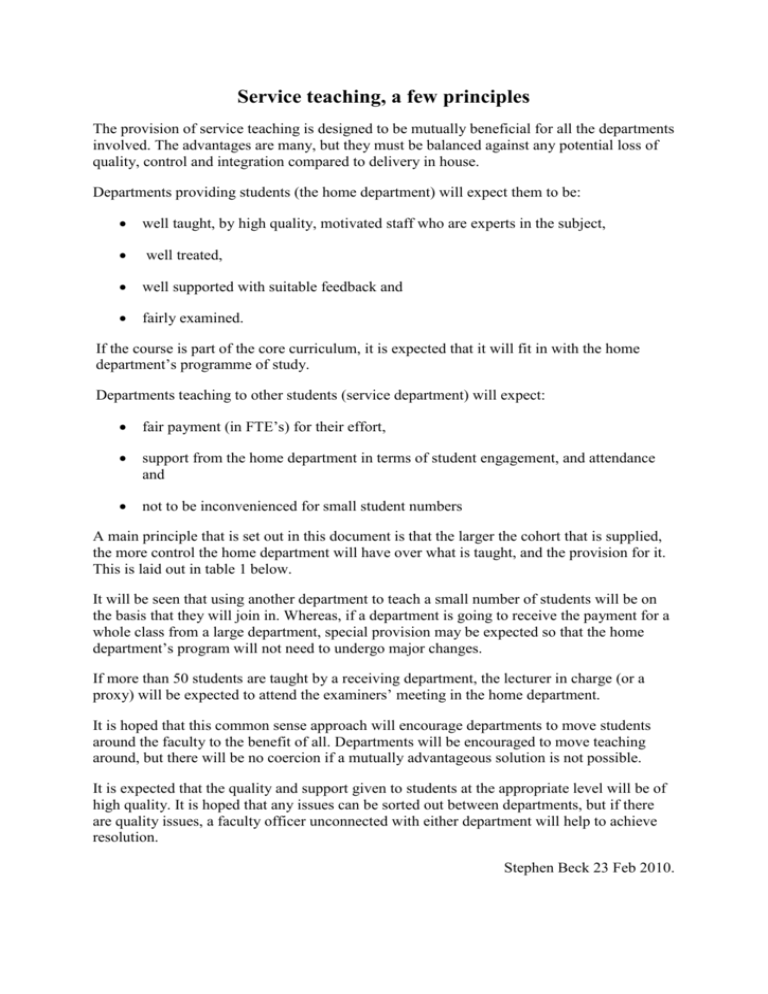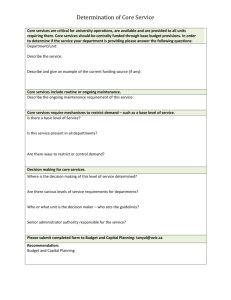Faculty of Engineering
advertisement

Service teaching, a few principles The provision of service teaching is designed to be mutually beneficial for all the departments involved. The advantages are many, but they must be balanced against any potential loss of quality, control and integration compared to delivery in house. Departments providing students (the home department) will expect them to be: well taught, by high quality, motivated staff who are experts in the subject, well treated, well supported with suitable feedback and fairly examined. If the course is part of the core curriculum, it is expected that it will fit in with the home department’s programme of study. Departments teaching to other students (service department) will expect: fair payment (in FTE’s) for their effort, support from the home department in terms of student engagement, and attendance and not to be inconvenienced for small student numbers A main principle that is set out in this document is that the larger the cohort that is supplied, the more control the home department will have over what is taught, and the provision for it. This is laid out in table 1 below. It will be seen that using another department to teach a small number of students will be on the basis that they will join in. Whereas, if a department is going to receive the payment for a whole class from a large department, special provision may be expected so that the home department’s program will not need to undergo major changes. If more than 50 students are taught by a receiving department, the lecturer in charge (or a proxy) will be expected to attend the examiners’ meeting in the home department. It is hoped that this common sense approach will encourage departments to move students around the faculty to the benefit of all. Departments will be encouraged to move teaching around, but there will be no coercion if a mutually advantageous solution is not possible. It is expected that the quality and support given to students at the appropriate level will be of high quality. It is hoped that any issues can be sorted out between departments, but if there are quality issues, a faculty officer unconnected with either department will help to achieve resolution. Stephen Beck 23 Feb 2010. Cohort size Lectures Tutorials Labs Monitoring Students join in with existing tutorials where possible. If not possible, home department will pay for postgraduate level tutorial support. Students join in with existing labs. If not possible, home department will pay for postdoctoral level laboratory supervision. Student feedback questionnaires Students join in with existing tutorials where possible. If not possible, service department will provide postgraduate level tutorial support. Students join in with existing labs. If not possible, service department will provide postdoctoral level laboratory supervision. Student feedback questionnaires Lecturer will be aware of their Students join in with existing presence and suitable examples can About half classes. Lecturers will be made be supplied as part of the course. of home aware of their presence and Students join in with existing department suitable examples can be tutorials . If not possible, service cohort supplied as part of the course. department will provide postdoctoral level tutorial support. Students join in with existing labs . If not possible, service department can provide special laboratory sessions. Student feedback questionnaires Students join in with existing classes. Lecturers will be Nearly all aware of them and suitable of home examples will be supplied as department part of the course. The home cohort department may negotiate for certain topics to be covered. Timetabled laboratory tutorial sessions can be supplied for students. Timetabled laboratory sessions can be supplied for students. Student feedback questionnaires. Attendance at examiners’ meeting. Annual meeting with DOT. Home department may provide Timetabled laboratory tutorial learning outcomes if needed. sessions can be supplied for Students may be taught students. separately. Timetabled laboratory sessions can be supplied for students. The topics and number will be agreed by both departments. Student feedback questionnaires .Attendance at examiners’ meeting. Annual meeting with DOT to discuss curriculum Very small Students join in with existing numbers classes. Small numbers Very large numbers Students join in with existing classes. changes.. Table 1: Principles of supply of service teaching: cohort size and support.






